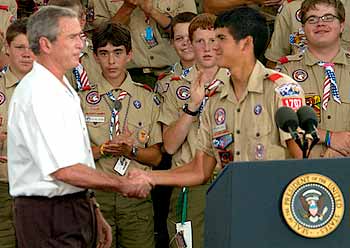Jamboree 2005
By Scott Daniels
The BSA's 10-day outdoor extravaganza highlights the best of what Scouting offers boys—fun, fellowship, physical fitness, and patriotism—plus for some, a brush with fame.
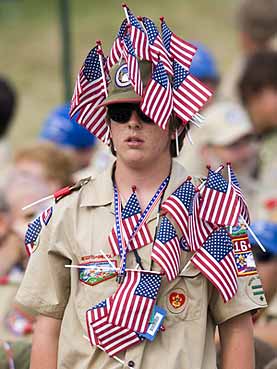 A Scout displays his patriotism |
Artist Andy Warhol once predicted that everyone would someday experience 15 minutes of fame. If that is true, then several young men cashed in last summer while attending the 16th National Scout Jamboree in Caroline County, Va.
Stephen Cox, a 16-year-old Life Scout from Troop 334 in St. Petersburg, Fla., took to the airways as a disc jockey for the jamboree's FM radio station.
"It's hot, hot, hot out there, so don't forget to drink plenty of water," Stephen reminded Scouts before a smooth segue into playing his next song. "This is 95.1, QBSA, with 'Pac Man Fever.'"
Venturer Sarah Kaechele, a jamboree staff member from Newtown, Conn., helped train the station's fledgling D.J.'s.
"This is a real radio station, licensed by the F.C.C. just for the jamboree," she said. "We may only have 100 watts of power, but we can be heard all across Fort A.P. Hill [nearly 76,000 acres] and as far as Fredericksburg [30 miles away].
"Every day we have 32, 15-minute music shifts," Sarah said. "Before a Scout goes on the air, he picks out three songs from our music library.
"We also have the guys read the weather forecast prepared by our own jamboree meteorologist," Sarah said. "When a Scout finishes his broadcast, we give him a CD recording of it as a souvenir."
Sending the story home
Two other jamboree Scouts, Michael Tellep and John Jones of Troop 615, Pottsville, Pa., pursued another high-profile medium—print journalism—as correspondents for Hometown News, a jamboree program for budding journalists.
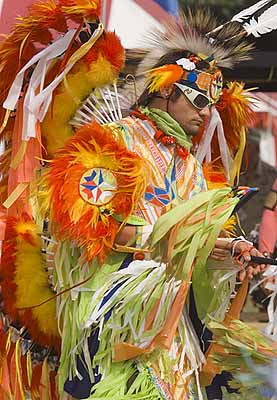 Travis Sheehan, an Eagle Scout from Jupiter, Fla., performs a southern Fancy Dance at the American Indian Village on the Merit Badge Midway. Photo by William Hodge |
They were among 800 young reporters who crisscrossed the jamboree on bicycles, interviewed Scouts, and then returned to write articles on laptop computers. Michael and John shared bylines on several stories published in their hometown paper, The Republican & Herald.
Having access to bicycles was a great bonus, John said, because otherwise he could never cover the jamboree's vast territory and return in time to file a story before deadline.
Another perk afforded to Hometown News correspondents, added Michael, was "getting ridiculously close-up seating to watch President Bush" during his address at a jam-packed arena show.
And that's when Eagle Scout Daniel Valella stepped into the spotlight.
An auspicious audition
"On the second day of the jamboree, my Scoutmaster asked if I wanted to try out for a speaking role at the arena show," Daniel said.
The 15-year-old from Troop 124 in Dallas, Tex., agreed and read through five or six practice scripts for show producers.
"They must have liked what they heard because then they handed me a script and said, 'This is the one we really want you to read.'"
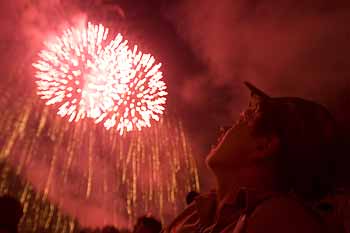 An awesome, 37-minute fireworks display highlighted the final arena show. |
Daniel looked at the typewritten page, sucked in a breath, and then read out loud, "Scouts and Scouters, ladies and gentlemen, please help me give a warm welcome to the 43rd president of the United States, the Honorable George W. Bush!"
Until that moment, Daniel had no idea he was auditioning to introduce the president. "I was shocked and surprised," he said, "but when they asked if I could handle it, I said O.K."
As Daniel stood before 70,000 people, the largest crowd ever to attend a jamboree arena show, he later admitted to having a few butterflies. But the young Texan was poised, polished, and delivered the introduction perfectly. President Bush walked onstage, shook Daniel's hand, and waved to a sea of cheering Scouts.
"It was absolutely an unforgettable experience," said Daniel. (See excerpts from President Bush's speech.)
'Cool' exhibits, nonstop fun
Brushes with fame are exciting, but by no means a requirement to having fun at the jamboree. Scouts flocked to zip lines and rappelling towers and places to sail, snorkel, scuba dive, and fish. There were trapshooting ranges, BMX dirt tracks, and Action Alley obstacle courses.
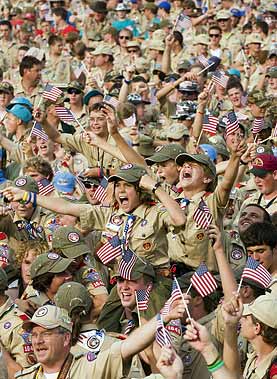 Thousands of Boy Scouts give President Bush an enthusiastic welcome at the closing arena show. Photo by Mark Duncan |
The weather was hot, especially during the early days of the jamboree. Those in the know, however, headed to the Venturing Mine Company, a supercool exhibit highlighting the BSA's program for young men and women ages 14 through 20.
"This is the biggest hit of the jamboree," said Steve Stone, a committee chairman for Venturing Crew 959 in San Diego. "The temperature inside is between 50 and 60 degrees to simulate conditions inside a real mine. The Scouts get a 30-minute tourŠlearn about mining operations, shoot air rifles, and experience a mine shaft 'earthquake.'"
Adult Scouters especially appreciated the exhibit's air-conditioned backstage room where, via a bank of television monitors, they could watch their Scouts traverse the mine.
All sorts of displays lined Thomas Road, the jamboree's main thoroughfare. Twelve-year-old Dylan Robertson of Troop 20, Wilton, Conn., was fond of the Navy's F/A- 18 Hornet flight simulator.
The five-minute ride zigged, zagged, and tilted up, down, and sideways, while Scouts inside the capsule viewed a dizzying movie of flight over cities, beaches, mountains, and forests.
"It's great!" exclaimed Dylan. "I've ridden it three times."
Scout skills, old and new
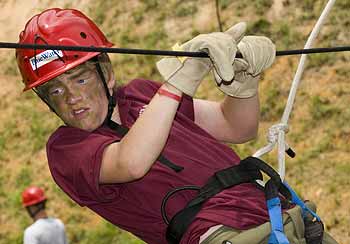 K. J. Erickson of Troop 285, Price, Utah, crosses a rope bridge at the Army Adventure Area. |
At the Merit Badge Midway, jamboree Scouts could pass requirements in nearly 80 subjects. Inside the Pioneering areas, Scouts took rides on a carousel constructed with rope swings, heavy timbers, and multiple lashes.
The top attraction at Pioneering was building Paul Bunyan-size wooden mallets from logs of pine and oak. Boys carrying the super-size hammers seemed to be everywhere.
Pioneering instructor Dan Peacock, an assistant Scoutmaster from Troop 40 in Gallup, N.M., taught boys how to make the mallets using a hand drill and drawknife.
"Scouts made 500 the first day of the jamboree and more than 1,000 the next," Peacock said. "I predict we will turn out more than 5,000 mallets before the jamboree ends."
If pioneering hearkens back to Scouting's most traditional campcraft, then a new jamboree activity, GPS geocaching, represents a leap forward to the newest skills in land navigation.
A geocache course was plotted in all 20 jamboree subcamps. Magellan donated global positioning satellite receivers and provided instruction on how to use them.
"Geocaching is like a high-tech scavenger hunt," explained Scout John VanDenBerghe.
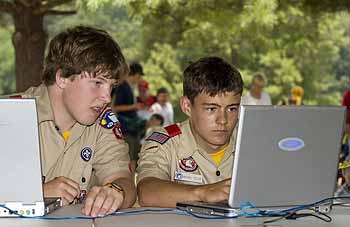 Hometown News correspondents John Jones and Michael Tellep write an article. |
He, along with pals Patrick Lindsey and Ethan White, all of Salt Lake City, tracked coordinates programmed into the handheld GPS unit. Their goal was to find clues scattered across the subcamp to unscramble a jumbled word puzzle.
"This is what's great about the jamboree," John said. "I'd never have the opportunity to do this back home."
As the Scouts dismantled their tent cities and packed for the return trip home, many reflected on their jamboree memories—a patch traded, an obstacle overcome, an awesome fireworks show.
It will be five years, instead of the usual four, before the BSA hosts another national jamboree. But there is a good reason for waiting that additional year. The Boy Scouts of America marks its 100th anniversary in 2010.
Just imagine the fireworks for that celebration!
Scott Daniels is the Executive Editor of Scouting magazine.
'Scouts Have Made America a Stronger and Better Nation'
It is a tradition that the president of the United States addresses Scouts at jamborees. President Bush's first attempt to visit the 2005 gathering was canceled because of approaching thunderstorms, but he graciously rescheduled his appearance for the jamboree's final arena show. The president began his remarks by expressing condolences for the tragic deaths of four adult Scouters killed in an electrical accident on the jamboree's first day. "These men will always be remembered for their leadership and kindness," he said. "And you Scouts honor them by living up to the ideals of the Scouting they served." The president then paused to survey the crowd of khaki-clad youth seated in front of him. "It's a fantastic sight to look out on more than 30,000 young men wearing the uniform of the Boy Scouts... "Coming to this jamboree gives me great confidence in the future of our nation. For nearly a hundred years, Boy Scouts have set a high standard of service and duty to God and country. Millions of Americans have pledged the Scout Oath: 'On my honor, I'll do my best.' And through the generations, Scouts have made America a stronger and better nation... "Across America, Scoutmasters and volunteers devote long hours to building the knowledge and integrity of our Scouts. It's not always an easy job. I want to thank the Scoutmasters of America and the volunteer Scouters for taking the time to care. I want to thank you for your leadership and thank you for setting such a good example for a new generation of Scouts." The president encouraged the Scouts to "always remember where you come from and what you believe. At times, you may come across people who say that moral truth is relative or call a religious faith a comforting illusion. They may question the values you learn in Scouting. But remember, lives of purpose are constructed on the conviction there is right and there is wrong, and we can know the difference. "In the years ahead you will find that indifferent or cynical people accomplish little that makes them proud. You'll find that confronting injustice and evil requires a vision of goodness and truth. You'll find that many in your community, especially those younger than you, look to you as an example of conduct and leadership. For your sake, and for the sake of our country, I hope you'll always strive to be men of conviction and character." See the complete text of the President's jamboree address at http://www.whitehouse.gov/news/releases/2005/07/20050731.html |
November - December 2005 Table of Contents
Copyright © 2005 by the Boy Scouts of America. All rights thereunder reserved; anything appearing in Scouting magazine or on its Web site may not be reprinted either wholly or in part without written permission. Because of freedom given authors, opinions may not reflect official concurrence.
